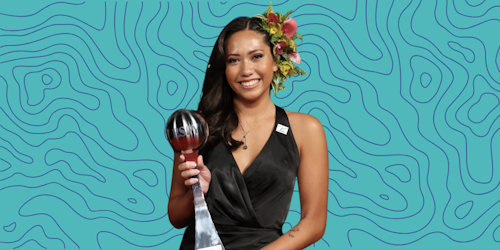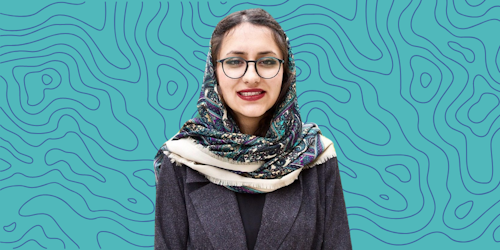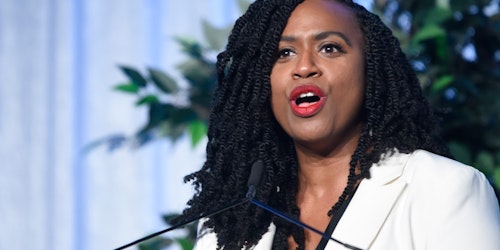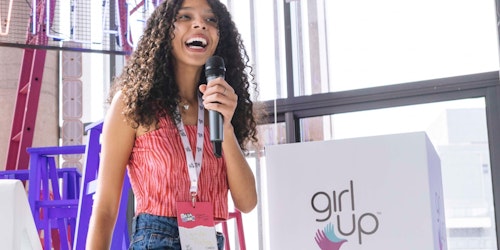Estimated reading time: 9 minutes
Mitzi Jonelle Tan is the dynamic force behind Youth Advocates for Climate Action Philippines (YACAP). Their commitment to catalyzing change is rooted in their first-hand experiences of the climate crisis’s impact in the Philippines. This Women’s History Month, Girl Up India is delving into Mitzi’s transformative path as a climate activist because climate and gender justice belong on the menu of every conversation. In this interview, we will explore the pivotal moments that shaped her dedication to amplifying marginalized voices, advocating for climate education and strategizing for collective action.
Can you tell us a little bit more about how you started your journey as a climate justice activist?
I grew up witnessing firsthand the grave impacts of the climate crisis, particularly in the Philippines, which stands as one of the world’s most climate-vulnerable nations. Storms often left us without electricity for days on end. Initially, I didn’t fully grasp that these challenges were linked to the climate crisis. The way it was presented in school, if it was discussed at all, seemed distant and disconnected from our local reality, emphasizing Western technicalities that felt foreign and alienating. It was portrayed as a distant, looming issue, something far removed from the urgent reality experienced by many in the Philippines.
It wasn’t until 2017 that a pivotal moment occurred for me – I had the opportunity to speak with an indigenous leader who shared stories of harassment, displacement, and violence faced by those like him protecting their ancestral lands and forests. He told me that that’s why we have no choice but to fight back and the way he said it burst my bubble of privilege. I realized that I had no choice but to also join the struggle of our environmental defenders. From that moment on, I committed myself to climate action and embarked on a journey of learning about the environmental challenges we face and dedicating my energy to advocating for change.
The Philippines is one of the most vulnerable countries in the world to the climate crisis. India, too, regularly sees the dangerous repercussions of disasters that have been enhanced by climate change. How critical is it to centre and champion voices from the Global South?
We really need to make sure we’re listening to indigenous folks and small-scale farmers and fisherfolk who are living harmoniously with nature every day. They’ve already adapted to the environment in their own ways because, more often than not, they’ve had no other choice. Just think about what could happen if we actually gave them the power to shape how we adapt to climate change. And let’s not forget about women and gender minorities. They’re on the front lines, and their voices are essential for finding real solutions. Even in wealthier countries from the Global North, there are marginalized folks who need to be part of these conversations.
Across social justice movements, education is often cited as a crucial tool in furthering change. Do you think conversations around climate change and justice need to be integrated into our educational systems?
Education, especially the kind we receive in schools, plays a vital role in shaping our understanding of the world. And a curriculum that teaches us about climate change and its impacts can truly empower us. Take, for example, what happened during Super Typhoon Haiyan in the Philippines back in 2013. The news warned people about a storm surge, but because it was an area that wasn’t normally hit by typhoons people didn’t know what it meant, so they didn’t evacuate and a lot of lives were lost. This is why teaching about climate is not just important, it’s essential for our survival.
But education doesn’t stop there. It’s not just about sitting in classrooms. We also need to listen to folks who have experienced the repercussions of climate change firsthand. They have valuable insights that can’t always be found in textbooks. Finally, it’s really important to also keep learning outside of schools, in community with other activists and advocates.
Teaching about climate is not just important, it’s essential for our survival.
Climate anxiety and eco-anxiety are on the rise worldwide. Studies show that young people are particularly vulnerable with nearly 62% saying they were anxious about climate change and about 67% saying they were sad and afraid. How do you think we can address this issue?
Joining organizations and communities is vital because it fosters a sense of togetherness and belonging. I think mobilizing and engaging individuals is an integral part of any campaign or movement. Furthermore, being part of a group that provides support and accountability is invaluable. Similar to the concept of an everlasting note in choirs, i.e., where one person can take a breath while others keep the note going, in a movement, we need to know that we can pause, take a breath, and keep moving in a coordinated manner. This collective resilience not only facilitates personal rejuvenation but also serves as a potent tool in dismantling oppressive structures.
There’s also joy in taking a break together, as I recently learned at a retreat where we meditated as a group. It was great to take care of each other without having to leave the community to take care of yourself and return when you’re ready. And even within yourself, you have a community – like your angry self, your tired self, your happy self, your sad self, your anxious self, your self that isn’t an activist, your self that is a student, etc.
I often approach my climate anxiety as a permanent guest in my home. Sometimes I can go through my day, but it’s there in the back of my mind. It’s happy when I’m an activist, taking action. But sometimes, if I’m taking a break, then my climate anxiety starts saying, “Why aren’t you paying attention to me?” and gets incredibly huge or lays on the floor like a child throwing a tantrum. In those moments, I try to just be like, “Okay, let’s breathe, I’ll give you a hug. I know that things are really scary right now, but I’m here with you.” I don’t always do this; sometimes I want to conceal it in a box and pretend it’s not there. However, a few years ago, a friend advised me to grieve if there is something to grieve. It was powerful to realize that allowing ourselves to feel the sadness and anguish of what we’re seeing around us is essential to processing it and taking action.
It was powerful to realize that allowing ourselves to feel the sadness and anguish of what we’re seeing around us is essential to processing it and taking action.
In another interview, you said you are “committed to changing the system and building a world that prioritizes people and planet, not profit, through collective action.” What are some strategies that young people just starting in climate movements can leverage to build a world like this?
Firstly, I would say, thank you for wanting to do something – that’s often the hardest part. Going from recognizing that there’s a problem to wanting to do something about it is often difficult. I wish I had known this when I was younger.
Looking back, I think my early activism focused a lot on wrath, loss, and despair, which were vital back then but were so exhausting that it became hard to keep going. Eventually, I realized that while we’re pulling down capitalism, imperialism, and injustices, we’re also constructing justice, love, care, and community. Therefore, you must do both. The nice thing is that you don’t always have to do everything. It’s necessary to trade responsibilities and relax and recover.
Recognizing the intricate relationship between the climate crisis and social justice is crucial. Our world is woven with injustices that can feel overwhelming. Regardless of the scale of your action and advocacy, your actions tug at these threads, influencing the unravelling process. Don’t spread yourself too thin across every cause though, or you’ll just wear yourself out. Remember, real change happens when we come together and take collective action. You’re not alone in this, so focus on what you can do rather than trying to do it all.
If you could think of an ideal world, what does that world look like for you?
The amazing thing is, I have felt it, and I’m sure you have felt it, too. This one time, after an international conference, some of us went out. I started crying while we were out dancing because we were listening to a song whose lyrics we didn’t understand and yet everyone was moving in unison together from different cultures despite not knowing each other. I think that’s what a better world is – us doing our own things, but in unison coordinated to the same harmony and beat for enjoyment. A world where we’re safe enough to be able to enjoy small things. We’re safe enough to be able to love or to feel all our feelings. And I think that’s what climate action is – breaking down all oppressive structures and injustices and then creating and building a world that is safe and joyous.
I think that’s what climate action is – breaking down all oppressive structures and injustices and then creating and building a world that is safe and joyous.
This interview has been edited for length and clarity.
Follow Girl Up India for more conversations on global feminist issues with the world’s most influential changemakers as a part of our ongoing series “Feminists Across Borders” on Instagram.








